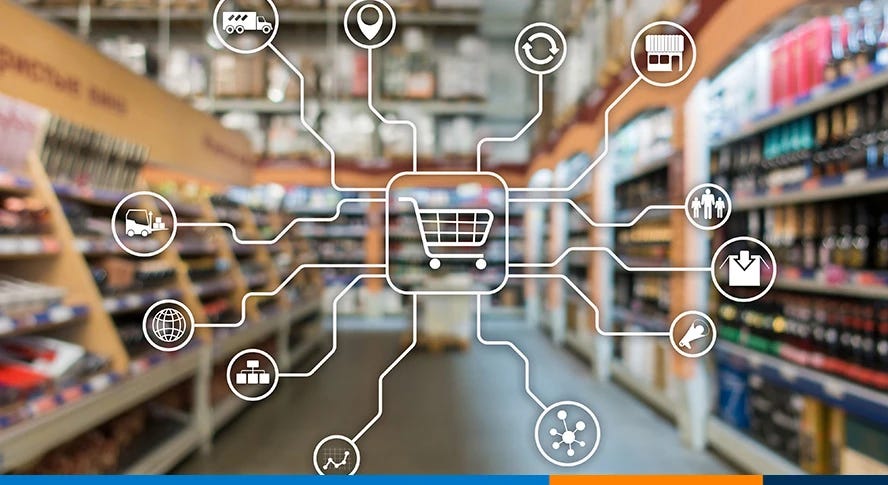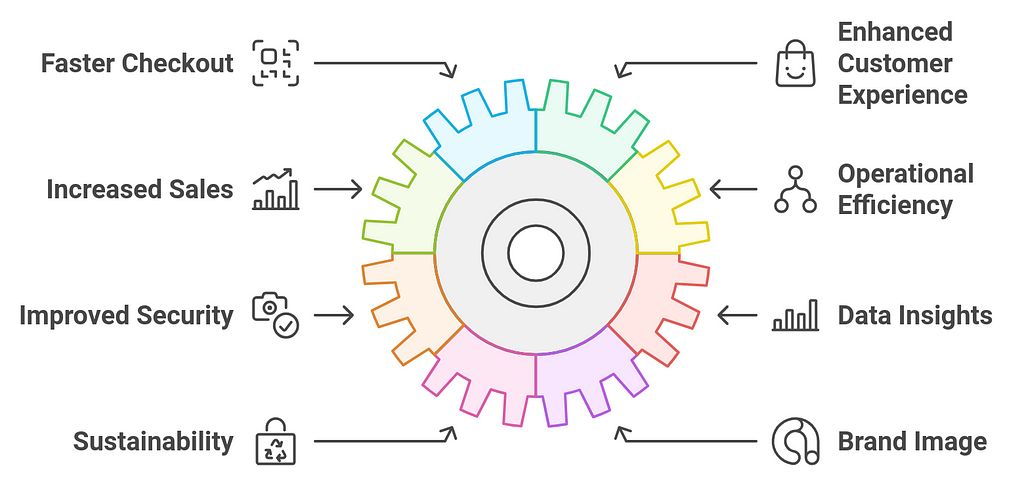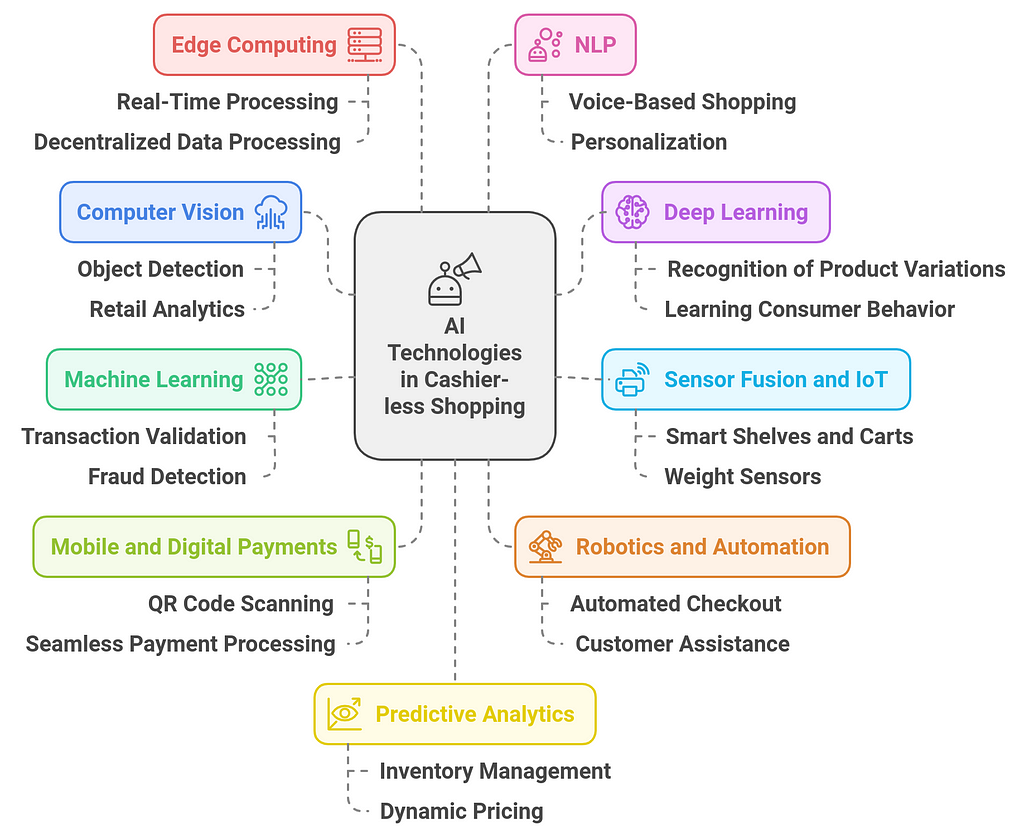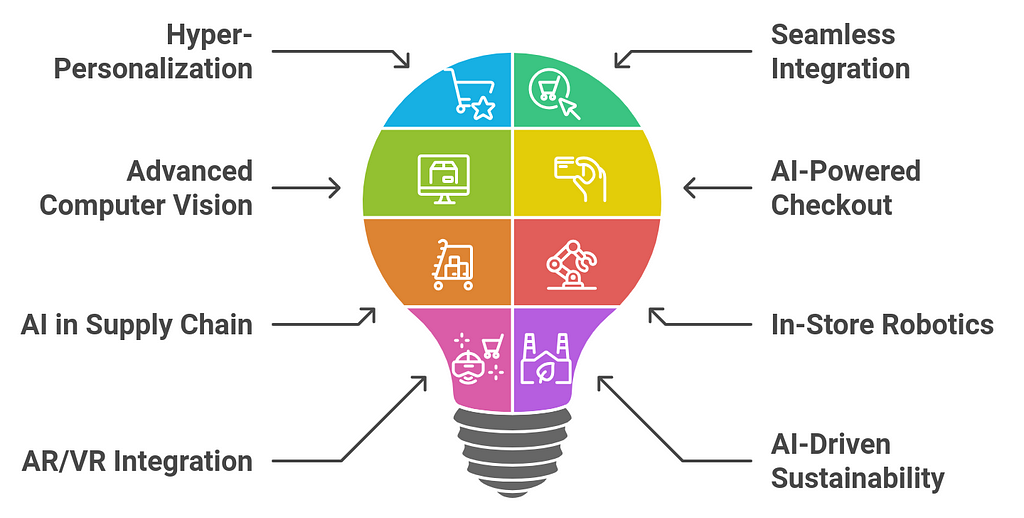AI You Can Trust: The Value of Explainable AI in 2025
Artificial Intelligence (AI) is revolutionizing the retail landscape by reshaping the cashier-less shopping experience. By leveraging advanced AI technologies such as computer vision, machine learning, and real-time data analysis, retailers are creating seamless, frictionless shopping environments where customers can browse, select, and pay for their items without the need for traditional checkout lines. AI-powered sensors and cameras automatically track the items customers pick up, while intelligent algorithms process the transaction and charge their accounts, ensuring a fast and secure purchase process.

This innovation not only enhances customer convenience by eliminating wait times but also improves operational efficiency for retailers by reducing the need for human cashiers and minimizing errors. Additionally, AI offers valuable insights into customer behavior, helping businesses optimize inventory, tailor promotions, and enhance personalized experiences. As AI continues to evolve, AI in cashier-less shopping is expected to become even more intuitive and integrated, further transforming the way consumers interact with stores and opening up new possibilities for the future of retail.
What is AI in Cashier-less TechnologyAI in cashier-less technology refers to the use of artificial intelligence systems to enable a fully automated shopping experience without the need for traditional checkout counters or human cashiers. This technology leverages a combination of AI-driven tools such as computer vision, machine learning, and sensor-based technology to track customer purchases in real time. Cameras and sensors embedded throughout the store monitor what products customers pick up and place in their carts, while AI algorithms process this information and automatically calculate the total cost of the items.
When customers are ready to leave, the system charges them via their connected payment methods, usually through a mobile app or digital wallet, without requiring them to stop at a checkout counter. AI plays a central role in ensuring the accuracy of item recognition, reducing errors, and enhancing the efficiency of the entire process. Additionally, AI can analyze shopper behavior, optimize inventory management, and offer personalized shopping experiences, making cashier-less technology more intuitive and effective in modern retail environments.
The Rise of Cashier-less ShoppingThe rise of cashier-less shopping is transforming the retail landscape by offering a more convenient, efficient, and futuristic way to shop. Enabled by advanced technologies like artificial intelligence, computer vision, and sensor-based systems, this innovation allows customers to shop without waiting in line or going through traditional checkout procedures. Retailers are using AI to automatically track and identify products as customers pick them up, while cameras and sensors monitor the shopping process in real time.
Once the customer finishes their shopping, the total is calculated automatically, and payment is processed through digital wallets or mobile apps. This seamless experience reduces wait times, improves customer satisfaction, and enhances operational efficiency for businesses. As a result, cashier-less shopping is gaining popularity across various sectors, from grocery stores to clothing retailers. As AI and automation continue to evolve, the cashier-less model is expected to expand, offering even more personalized and frictionless shopping experiences in the future.
Key Benefits of AI-driven Cashier-less ShoppingAI-driven cashier-less shopping offers a range of benefits that enhance both the customer experience and operational efficiency for retailers. These benefits can help transform the way consumers shop while providing businesses with improved profitability and streamlined operations. Here are the key benefits of AI-driven cashier-less shopping:
 1. Faster and More Convenient Checkout
1. Faster and More Convenient Checkout- Seamless Checkout Process: AI-powered cashier-less systems allow customers to bypass long lines and traditional checkout counters. Customers can simply grab what they need and walk out, with their purchases automatically detected and billed through their mobile app or a linked account.
- Time Savings: With no need to stand in line, shoppers save valuable time, making the experience faster and more efficient. This leads to increased customer satisfaction and improved overall shopping efficiency.
- Personalized Shopping: AI can analyze customer behavior and preferences to offer personalized product recommendations and tailored promotions in real-time. This can enhance the overall shopping experience and increase the likelihood of additional purchases.
- Reduced Friction: The removal of traditional barriers to purchasing (like checkout lines and cashiers) reduces the friction between decision-making and purchasing, improving the overall shopping experience.
- Convenience: Customers can shop at their own pace without having to worry about queues or waiting for cashier assistance.
- Impulse Purchases: Faster and more convenient shopping experiences can encourage impulse buying, as customers are less likely to abandon their shopping carts when there are no lines or delays.
- Loyalty Programs: AI-powered systems can easily integrate loyalty programs, tracking purchases and offering rewards and discounts based on customer behavior, thus encouraging repeat business and building customer loyalty.
- Increased Throughput: With the elimination of the traditional checkout process, more customers can be served in less time, potentially leading to an increase in the number of transactions and overall sales.
- Reduced Labor Costs: With no cashiers required, retailers can reduce staffing costs, freeing up employees to perform other tasks, such as customer service or inventory management. This is especially valuable in stores that operate with a high volume of traffic.
- Streamlined Inventory Management: AI systems can automatically track product availability and detect inventory discrepancies in real-time. This can help retailers optimize inventory levels, reduce stockouts, and prevent overstocking.
- Lower Operational Overhead: The technology reduces the need for hardware like cash registers and point-of-sale systems, lowering the costs associated with maintaining and upgrading physical checkout infrastructure.
- Real-Time Monitoring: AI-powered cameras and sensors track customers’ actions, which can significantly reduce theft and fraud. If an item is taken without proper checkout, the system can alert security or the customer in real-time.
- Behavioral Analytics: AI systems can also analyze customer behavior and flag suspicious actions that might indicate potential theft, such as taking items without scanning them or lingering in specific areas of the store.
- Better Accountability: AI systems can create detailed logs of every transaction and product movement, providing retailers with a transparent and traceable record of all store activities.
- Customer Behavior Insights: AI-driven cashier-less systems collect and analyze vast amounts of data on customer preferences, buying habits, and traffic patterns. This data can be used to gain insights into consumer behavior, optimize store layouts, and improve product offerings.
- Real-Time Analytics: Retailers can receive real-time data about sales, inventory levels, and customer flow, allowing them to make on-the-fly adjustments to staffing, inventory, and marketing strategies.
- Targeted Marketing: By analyzing shopping patterns, AI can help retailers tailor marketing campaigns and offers to specific customer segments, improving conversion rates and maximizing the impact of promotions.
- Reduced Waste: With better inventory tracking and demand forecasting, AI can help reduce overstocking, which leads to less waste and more efficient use of resources.
- Paperless Transactions: Cashier-less systems typically rely on digital receipts and mobile payments, which reduces paper waste and helps stores transition to more eco-friendly operations.
- Optimized Energy Usage: AI systems can also be integrated into smart energy management systems to optimize lighting, heating, and cooling in the store, contributing to energy savings and reducing the store’s carbon footprint.
- Easy to Scale: AI-driven cashier-less systems can be easily scaled across multiple locations, enabling retailers to expand their operations without significant increases in overhead or personnel. The same technology can be implemented across multiple stores in various locations.
- Adaptability: These systems can be adapted to different store formats (e.g., convenience stores, supermarkets, or large retail outlets) and be customized to fit a retailer’s specific needs or business model, from small pop-up stores to large retail chains.
- Reduced Contact Points: Especially relevant in the post-pandemic world, cashier-less shopping minimizes the need for physical interaction, helping reduce the spread of germs and creating a safer shopping environment for both customers and employees.
- Enhanced Hygiene: With fewer touchpoints (such as cash registers, card readers, or shared keypads), the risk of contamination is lowered, contributing to a cleaner, more hygienic shopping experience.
- Modern and Innovative Perception: Retailers that implement cashier-less systems can position themselves as tech-savvy, innovative, and customer-centric, appealing to a younger, tech-forward audience.
- Competitive Advantage: Being an early adopter of cutting-edge technology gives retailers a competitive advantage, as customers increasingly expect seamless, tech-driven shopping experiences. This can differentiate the brand in a crowded market and attract a loyal customer base.
AI-driven cashier-less shopping offers a wide array of benefits that enhance the shopping experience for customers while improving operational efficiency for retailers. From speed and convenience to personalization, cost savings, and data-driven insights, AI is transforming how retailers operate and how consumers engage with stores. As technology continues to advance, these benefits will likely expand, further cementing cashier-less shopping as a key part of the future retail landscape.
AI Technologies Driving Cashier-less ShoppingAI technologies are revolutionizing the retail landscape, and cashier-less shopping is one of the most exciting developments in this space. By leveraging AI, machine learning, computer vision, and other advanced technologies, retailers can offer frictionless shopping experiences that remove the need for traditional checkout lines and cashiers.

Here are the key AI technologies driving cashier-less shopping:
1. Computer VisionComputer vision plays a central role in cashier-less shopping. It enables the system to understand and track what items a shopper picks up and places in their shopping cart, eliminating the need for manual scanning.
- Object Detection: Computer vision models identify and classify products in real-time by processing camera feeds. This helps the system track the products as they are picked, placed in the cart, or added to the shopping bag.
- Retail Analytics: Vision-based technologies are also used to analyze customer behavior, optimizing store layouts and product placements based on how people interact with different sections of the store.
AI-powered deep learning models are employed for tasks like image recognition, motion tracking, and transaction analysis. These models are trained on large datasets to recognize product images and map them to the right inventory items.
- Recognition of Product Variations: Deep learning helps in recognizing various product variations (sizes, colors, brands) even when there is no bar code to scan.
- Learning Consumer Behavior: AI can analyze patterns of customer behavior to predict purchases and optimize pricing, promotions, and inventory.
AI-integrated sensors, RFID tags, and IoT devices work together to track products in real-time and understand customer actions within the store.
- Smart Shelves and Smart Carts: RFID tags or Bluetooth-based technology help track products as they move around the store. Smart shelves can notify the system when an item is picked up or removed.
- Weight Sensors: Some cashier-less stores utilize weight sensors embedded in shelves or carts to confirm which products are being added and whether a customer has removed an item.
Machine learning algorithms process large amounts of data to make decisions about what items customers are buying, how much they should be charged, and whether there are any discrepancies in the shopping behavior.
- Transaction Validation: AI models use historical data, user behavior, and transaction patterns to ensure that customers are billed accurately for the items they’ve selected.
- Fraud Detection: Machine learning can also help detect fraudulent activities, such as attempts to steal or avoid payment, by analyzing anomalies in customer behavior or checkout patterns.
AI-enabled mobile apps and digital wallets are used in cashier-less stores to allow customers to pay directly via their smartphones.
- QR Code Scanning: In some systems, customers use their mobile apps to scan a QR code, which then logs their purchases and automatically handles the payment when they leave.
- Seamless Payment Processing: Mobile-based payment solutions powered by AI detect when the customer is about to leave the store and automatically process the payment based on the items in their cart.
Some cashier-less stores use AI-driven robots to assist with tasks like product retrieval, shelf stocking, and even assisting customers in finding items.
- Automated Checkout: Robots can assist with checkout by identifying products and facilitating an automatic billing process without requiring human intervention.
- Customer Assistance: Robots can be equipped with AI assistants to guide customers to products, offer suggestions, or provide promotions, enhancing the in-store experience.
AI-powered systems in cashier-less stores often rely on edge computing to process data locally and quickly, minimizing latency and ensuring a seamless shopping experience.
- Real-Time Processing: Edge computing allows AI models to process video and sensor data in real time, so the system can immediately recognize when an item is picked or returned to the shelf, and update the virtual shopping cart accordingly.
- Decentralized Data Processing: Edge computing also reduces reliance on central servers, improving system efficiency and reducing the risk of system failures.
NLP technology can be used to provide voice-based assistance for customers and employees in cashier-less stores. AI assistants, powered by NLP, can help customers with product inquiries, recommend products, and help with checkout.
- Voice-Based Shopping: Customers can ask for product details, recommendations, or even request checkout assistance using natural language.
- Personalization: NLP can enable personalized interactions based on customer preferences, enhancing the shopping experience.
AI technologies in cashier-less shopping also rely on predictive analytics to forecast customer needs, manage inventory, and optimize product placement within stores.
- Inventory Management: AI systems can predict product demand in real-time based on factors like seasonality, customer behavior, and historical sales, allowing stores to maintain optimal stock levels.
- Dynamic Pricing: AI-powered systems can adjust pricing based on demand and competitor activity, ensuring competitive and fair pricing for customers.
AI technologies, including computer vision, deep learning, IoT, machine learning, and mobile payments, are transforming the way consumers shop by enabling cashier-less stores. These systems offer a more efficient, convenient, and personalized shopping experience, with benefits ranging from faster checkout times to reduced operational costs. As the technology continues to advance, cashier-less shopping is expected to become more widespread and refined, further disrupting traditional retail.
Challenges and ConcernsDespite the benefits, cashier-less shopping faces several challenges and concerns that need to be addressed for widespread adoption. One of the primary issues is the high cost of implementing the necessary technology, including AI systems, cameras, and sensors, which can be a significant investment for retailers, especially small businesses. Additionally, there are concerns about privacy and data security, as the systems collect a vast amount of customer information, such as purchase habits and payment details. This raises potential risks of data breaches and misuse.
Another challenge is the technology’s reliance on accurate product recognition, which can sometimes fail, leading to errors in pricing or inventory tracking. Furthermore, there is the issue of accessibility for certain demographics, such as elderly customers or those less familiar with digital payment methods, who may struggle with the cashier-less model. Lastly, job displacement is a concern, as cashier-less systems could reduce the need for human employees, potentially affecting the retail workforce.
Future of AI in Retail and Cashier-less ShoppingThe future of AI in retail and cashier-less shopping is exciting and transformative. As technology continues to evolve, AI will increasingly drive new ways for consumers to shop, while also providing retailers with innovative tools to enhance efficiency, personalization, and customer experience. Here’s a look at the key trends and innovations that will shape the future of AI in retail and cashier-less shopping:
 1. Hyper-Personalization of Shopping Experiences
1. Hyper-Personalization of Shopping ExperiencesAI will enable even more personalized shopping experiences. Leveraging consumer data, machine learning, and AI algorithms, retailers will be able to anticipate what individual customers want, when they want it, and even predict future purchases.
- Predictive Shopping: AI will go beyond basic product recommendations to offer highly tailored shopping experiences. For instance, it could predict what products a customer might need before they even decide to buy them, offering real-time discounts or promotions based on their shopping history.
- Dynamic Pricing: AI will optimize pricing in real-time based on a customer’s preferences, shopping patterns, location, and demand. This could lead to price fluctuations throughout the day, encouraging more personalized and targeted offers.
In the future, AI will play a key role in creating a more integrated omnichannel shopping experience that seamlessly connects physical and digital retail environments.
- Unified Shopping Carts: Consumers will be able to add items to their shopping cart both online and in-store, with the ability to purchase through any channel at any time. AI will track inventory, preferences, and cart items, providing a consistent and personalized experience across all touchpoints.
- Cross-Channel Loyalty Programs: Retailers will use AI to manage loyalty programs that integrate both physical and online purchases, offering rewards and discounts that are applicable regardless of where the transaction occurs.
The role of computer vision will continue to expand, offering deeper integration with retail operations.
- More Accurate Item Tracking: AI-powered vision systems will become even more accurate in identifying products, ensuring seamless tracking as consumers pick up, place, or put back items. This will eliminate errors and improve the reliability of cashier-less checkouts.
- Automated Shelf Restocking: Computer vision will also help automate inventory management by identifying stock levels, tracking product locations, and triggering restocking processes in real time.
- Facial Recognition for Payments: As privacy and security concerns evolve, facial recognition may be used in combination with AI to authenticate customers and enable contactless payment systems in physical stores, enhancing convenience and reducing fraud.
In the near future, cashier-less systems will become fully autonomous, reducing human intervention even further.
- True Autonomous Stores: AI will take over all aspects of the shopping experience, from product recognition and inventory management to customer checkout and payment. Customers could walk into a store, take what they want, and leave without having to interact with any devices, as everything would be handled by AI-driven cameras, sensors, and mobile apps.
- Voice and Gesture-Based Payments: Advances in natural language processing (NLP) and gesture recognition could enable customers to check out or confirm purchases via voice commands or simple hand gestures, eliminating the need for physical interaction with mobile devices or kiosks.
AI will further revolutionize supply chain management and inventory optimization for retailers, helping them improve efficiency and reduce costs.
- Predictive Restocking: AI will use historical data, seasonal trends, and external factors like weather or local events to predict demand, enabling retailers to restock products automatically before they run out.
- Smarter Logistics: AI-powered systems will manage logistics, from determining the most efficient routes for product delivery to minimizing transportation costs, ensuring products are always available at the right time and place.
Robots and automation will play an increasingly important role in cashier-less stores, with AI enhancing their capabilities.
- Robotic Store Assistants: Retailers will deploy robots that can guide customers, answer questions, assist with finding items, and even check out purchases. These robots will be powered by advanced AI-driven NLP and machine learning to understand customer queries and provide real-time support.
- AI for Cleaning and Maintenance: Retailers may use AI-driven robots for in-store cleaning, maintenance, and even restocking shelves, allowing human staff to focus on higher-value tasks and ensuring a smooth operation.
The future of AI in retail will include the integration of AR and VR for more immersive shopping experiences.
- Virtual Try-Ons: AI-powered AR will allow customers to try on clothes, makeup, and accessories virtually. Using their mobile phones or in-store AR displays, they will be able to visualize how products look on them without physically trying them on.
- Virtual Shopping Assistants: Retailers may develop AI-powered virtual assistants that guide customers through AR/VR shopping environments, helping them find items, make purchase decisions, and even check out in real time.
AI will also help retailers meet their sustainability and ethical goals by optimizing operations and minimizing waste.
- Sustainable Supply Chains: AI can be used to create more sustainable supply chains by identifying more eco-friendly sourcing options, predicting waste, and promoting ethical consumer behavior (e.g., through sustainable product recommendations).
- Waste Reduction: AI systems can track inventory more efficiently, reducing overstocking, spoilage (in food and perishable goods), and excess packaging waste.
- Carbon Footprint Monitoring: AI will enable retailers to track and reduce their carbon footprints through more efficient logistics, energy use, and resource management in stores and supply chains.
The integration of AI-powered chatbots and virtual assistants will improve customer service both online and in physical stores.
- AI-Driven Service and Support: Shoppers will have access to virtual assistants that can handle inquiries, provide personalized product recommendations, and even help with in-store navigation. These AI agents will be able to solve issues without human intervention, using machine learning to continually improve responses.
- Voice-Based Interactions: Retailers will incorporate AI-driven voice assistants into stores, allowing customers to make purchases, ask questions, or receive assistance hands-free.
AI will play an increasingly vital role in securing cashier-less shopping systems and ensuring that transactions are safe.
- Fraud Detection: AI will help identify fraudulent activities, such as suspicious shopping behaviors or payment anomalies, in real time, preventing theft and ensuring secure transactions.
- Advanced Authentication: Beyond passwords and PINs, biometric authentication (like facial recognition or voiceprints) will become a standard in cashier-less systems, offering additional layers of security.
The future of AI in retail and cashier-less shopping holds immense potential, from creating frictionless and personalized shopping experiences to improving operational efficiency and sustainability. As AI continues to evolve, retailers will be able to offer smarter, more efficient, and more secure shopping experiences, while consumers will enjoy greater convenience, customization, and seamless interactions with technology. These advancements will not only change how we shop but also how retailers manage their entire operations, paving the way for a more automated, efficient, and customer-centric retail landscape.
ConclusionIn conclusion, Artificial Intelligence is playing a pivotal role in reshaping the future of retail by driving the evolution of cashier-less shopping experiences. By automating key processes like product identification, transaction processing, and customer tracking, AI is creating a more efficient and seamless shopping journey. This not only eliminates the need for traditional checkout systems but also enhances convenience and reduces wait times for consumers. For retailers, AI offers the opportunity to optimize operations, reduce costs, and gain deeper insights into customer preferences, enabling personalized experiences and more efficient inventory management.
As AI continues to advance, we can expect cashier-less shopping to become even more intuitive and widespread, offering a glimpse into the future of a more automated, data-driven retail ecosystem. With benefits for both customers and businesses, AI-driven cashier-less shopping is poised to redefine how we shop, offering a more connected, efficient, and innovative approach to retail.
How is Artificial Intelligence Redefining Cashier-less Shopping Experiences? was originally published in Coinmonks on Medium, where people are continuing the conversation by highlighting and responding to this story.
